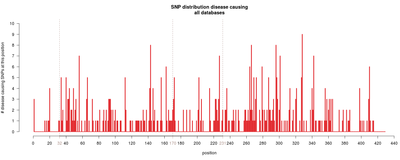Difference between revisions of "Fabry:Mapping point mutations"
Staniewski (talk | contribs) |
Staniewski (talk | contribs) |
||
| Line 41: | Line 41: | ||
|- |
|- |
||
|} |
|} |
||
| + | </figtable> |
||
== HGMD == |
== HGMD == |
||
Revision as of 09:24, 10 June 2012
Fabry Disease » Mapping point mutations
The following analyses were performed on the basis of the α-Galactosidase A sequence. Please consult the journal for the commands used to generate the results.
Database comparison
<figtable id="tab:database_comparison"> Comparison of the databases used for the analysis
| Database name | Information given | Last updated | Evidence |
|---|---|---|---|
| dbSNP | |||
| HGMD | |||
| OMIM | |||
| SNPdbe | |||
| SNPedia |
</figtable>
HGMD
Mutation types:
- Missense/nonsense
- Splicing
- Regulatory
- Small deletions
- Small insertions
- Small indels
- Gross deletions
- Gross insertions
- Complex
- Repeats
dbSNP
At the time we checked dbSNP, it listed eight silent single point mutations.
OMIM
<figure id="fig:OMIM_SNPs">
</figure>
The OMIM database lists 62 (actually 63, since one entry contains 2 SNPs) allelic variants for the gene GLA. Of these, 6 are exon deletions, 10 are base pair deletions, 4 are located in non-coding regions, 1 was an exon duplication and 2 Insertions (see OMIM data-Allelic variants). The remaining 40 variants are specified as SNPs and are listed in OMIM data-SNPs.
Of course, all of the mentioned mutations are disease causing. In <xr id="fig:OMIM_SNPs"/> we show the distribution of SNPs along the sequence of the α-galactosidase A coding gene. There seems to be no real "hotspot" of SNPs, but a long strip of sequence without any point mutation (position 66-112). In the signal peptide only one mutation is listed, and in at the active site amino acids (170 and 231), as well as the binding site (203-207) there are none.
SNPedia
<figure id="fig:SNPedia_SNPs">
</figure>
In SNPedia exists a site for the disease, that is caused by mutations in the gene we are examining, Fabry Disease, but not for the gene itself (GLA).
Thus we performed a query with the search term "Gene=GLA", which resulted in 40 hits (see SNPedia_data). 32 are missense mutations and the remaining 8 are stop-gained.
Again, only one hit was in the signal peptide part of the sequence and none of the important residues is mutated (see <xr id="fig:SNPedia_SNPs"/>).
The gap of no variation between position 66 and 112 can be observed as well and besides from that a rather even distribution without big peaks.
Without deeper look, it can be said, that the results from OMIM and SNPedia are very similar, by simply comparing <xr id="fig:SNPedia_SNPs"/> and <xr id="fig:OMIM_SNPs"/>
SNPdbe
<figure id="fig:SNPdbe_SNPs">
</figure> <figure id="fig:SNPdbe_SNPs2">
</figure>
A search in the SNPdbe database revealed 57 mutations (source), which are listed in SNPdbe data SNPdbe lists 35 desease causing and 22 non-disease causing mutations (see <xr id="fig:SNPdbe_SNPs2"/>). The distribution of disease causing SNPs again looks similar to the distributions of OMIM and SNPedia
(see <xr id="fig:SNPedia_SNPs"/> and <xr id="fig:OMIM_SNPs"/>), although there are more SNPs in the signal peptide region (position 1-31) and the gap is closed by one mutation at position 94.
Here, the distribution of SNPs that are not causing Fabry's Disease (or any other disease) appears to be homogeneous, except for a long sequence part from residue 29 to 117.
If we use only confirmed point mutations (see <xr id="fig:SNPdbe_SNPs_conf"/>), the plot looks very different, since there are only few non-disease causing SNPs left (7).
<figure id="fig:SNPdbe_SNPs_conf">
</figure>
Mapping
<figtable id="tab:pics_SNPdist_all"> SNP distribution of all databases
</figtable>
For a first overview of the number of SNPs at each position, we displayed the disease and non-disease causing SNPs along the sequence. <xr id="tab:pics_SNPdist_all"/> shows, that there are, of course, way more disease causing point mutations (red) than non-disease causing and silent ones (green). Both groups appear to be distributed evenly along the sequence, but since we wanted to be sure, we created a histogram. Important to note here, is that <xr id="tab:pics_SNPdist_all"/> lists all hits of all databases, but in the histograms, redundant information is filtered out. (INSERT HIST HERE).
In order to discover the overlap of the different databases, we displayed each SNP as a point along the sequence, indicating, whether it causes Fabry Disease, or not and which database the information was gained from. We tried to display all databases, but since there are too many HGMD hits, and no real hotspots of the SNPs in this database could be seen (see Fabry_posvssd_all.png), we decided too display only the remaining four databases in <xr id="fig:posvssd_noHGMD"/>.
Here, it becomes obvious, that the disease causing mutations have almost 100% coverage (pink, green and blue points almost never appear alone, but most of the time in triplets), while the non-disease causing point mutations do not group together.
<figure id="fig:posvssd_noHGMD">
</figure>







